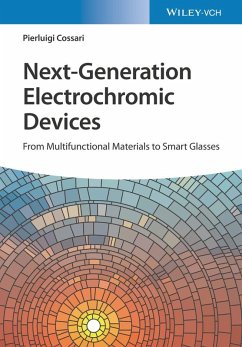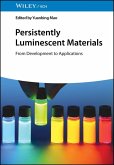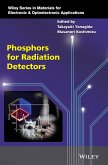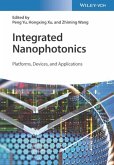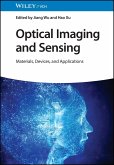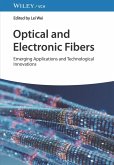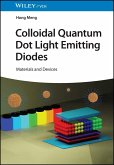Pierluigi Cossari
Next-Generation Electrochromic Devices
From Multifunctional Materials to Smart Glasses
Pierluigi Cossari
Next-Generation Electrochromic Devices
From Multifunctional Materials to Smart Glasses
- Gebundenes Buch
- Merkliste
- Auf die Merkliste
- Bewerten Bewerten
- Teilen
- Produkt teilen
- Produkterinnerung
- Produkterinnerung
Covers the basic concepts of multifunctional materials and their potential exploitation for the design of electrochromic and integrated systems.
Andere Kunden interessierten sich auch für
![Organic Electronics for Electrochromic Materials and Devices Organic Electronics for Electrochromic Materials and Devices]() Hong MengOrganic Electronics for Electrochromic Materials and Devices119,99 €
Hong MengOrganic Electronics for Electrochromic Materials and Devices119,99 €![Persistently Luminescent Materials Persistently Luminescent Materials]() Y MaoPersistently Luminescent Materials104,99 €
Y MaoPersistently Luminescent Materials104,99 €![Phosphors for Radiation Detectors Phosphors for Radiation Detectors]() Takayuki YanagidaPhosphors for Radiation Detectors208,99 €
Takayuki YanagidaPhosphors for Radiation Detectors208,99 €![Integrated Nanophotonics Integrated Nanophotonics]() Integrated Nanophotonics105,99 €
Integrated Nanophotonics105,99 €![Optical Imaging and Sensing Optical Imaging and Sensing]() Optical Imaging and Sensing97,99 €
Optical Imaging and Sensing97,99 €![Optical and Electronic Fibers Optical and Electronic Fibers]() L WeiOptical and Electronic Fibers97,99 €
L WeiOptical and Electronic Fibers97,99 €![Colloidal Quantum Dot Light Emitting Diodes Colloidal Quantum Dot Light Emitting Diodes]() Hong MengColloidal Quantum Dot Light Emitting Diodes104,99 €
Hong MengColloidal Quantum Dot Light Emitting Diodes104,99 €-
-
-
Covers the basic concepts of multifunctional materials and their potential exploitation for the design of electrochromic and integrated systems.
Produktdetails
- Produktdetails
- Verlag: Wiley-VCH
- Artikelnr. des Verlages: 1134925 000
- 1. Auflage
- Seitenzahl: 368
- Erscheinungstermin: Juli 2025
- Englisch
- Abmessung: 252mm x 179mm x 27mm
- Gewicht: 666g
- ISBN-13: 9783527349258
- ISBN-10: 3527349251
- Artikelnr.: 71913349
- Herstellerkennzeichnung
- Wiley-VCH GmbH
- Boschstraße 12
- 69469 Weinheim
- wiley-vch@kolibri360.de
- Verlag: Wiley-VCH
- Artikelnr. des Verlages: 1134925 000
- 1. Auflage
- Seitenzahl: 368
- Erscheinungstermin: Juli 2025
- Englisch
- Abmessung: 252mm x 179mm x 27mm
- Gewicht: 666g
- ISBN-13: 9783527349258
- ISBN-10: 3527349251
- Artikelnr.: 71913349
- Herstellerkennzeichnung
- Wiley-VCH GmbH
- Boschstraße 12
- 69469 Weinheim
- wiley-vch@kolibri360.de
Pierluigi Cossari, PhD, is a researcher at National Research Council, Institute of Nanotechnology, CNR -NANOTEC, Italy, where he focuses on the development and electrochemical characterization of solid-state polymer electrolytes and conducting polymer materials for next-generation electrochromic, photoelectrochromic and multifunctional devices. Since 2010, he has published numerous articles in different prestigious peer-review journals, participated in the writing of divulgative essays on electrochromism, emerging materials and devices, and authored a patent for the invention of a multifunctional solid-state device for solar control, photovoltaic conversion, and artificial lighting.
Preface
About the Author
Acknowledgments
1. Introduction
1.1. Electrochromism and Electrochemistry: a Brief Note on the History and Recent Evolution
Part I: Materials
2. Electrochromic Materials
2.1. Inorganic Electrochromic Materials
2.2. Two Dimensional (2D) Electrochromic Materials
2.3 Organic Electrochromic Materials
3 Mixed Ion and Electron Conductors (MIECs)
3.1 Semiconducting Polymers and Small Molecules
3.2 Structure-Properties Relationship and Charge Transport in Disordered Organic Materials
3.3 Potential Impact of Mixed Conductors on the Design of new EC and Multifunctional Devices
4. Electrolytes
4.1 Liquid Electrolytes
4.2 Polymer Electrolytes: from Gel to Solid Polymers
4.3 Inorganic Electrolytes
5 Electrodes
5.1 Transparent and Conducting oxides
5.2 Carbon-Based Electrode Materials
5.3 Metal Nanowires and Metal Grids
6 Critical Material Issues
Part II: Devices
7. Device Structure: the Key Role of the Interfaces in the Device Design
7.1 Electrochromic Device
7.2 Electrochromic Multifunctional Devices
8. Thin Films Processing Technologies
8.1 Chemical Deposition
8.2 Physical Deposition
9. Analysis of Device Performance
9.1. Optical Spectroscopy
9.2 Electrochemical Analysis
9.3 Chemical and Physical Methods for Analysis of Electrochromism and Material Properties
9.4 Characterization of Mixed Ion Electronic Conduction Materials
Part III: Industrial Scale-up, Energy and Environment, Next-Generation Technologies
10 Construction of Smart Windows: From Laboratory to Industry Scale-Up
10.1 Manufacturing Processes: Materials and Deposition Techniques
10.2 Scale-up Procedures: EC Windows and Large Area PV modules
10.3 Laminated Smart Windows and Adhesive EC Smart Films
11. Energy-Efficient Glazings for Green Buildings
11.1 Energy Demand and Consumption in Buildings: Energy Saving of EC Glazings
11.2 Effect of Electrochromic Glazings on Visual Comfort: Usable Daylight Illuminance (UDI) and Discomfort Glare Index (DGI)
12 Emerging and Next-Generation Technologies for Dynamic Tintable Windows
12.1 Smart Photoelectrochromic and Thermochromic Windows: Green Technologies Towards More Sustainable Buildings
12.2 Emerging and Next-Generation Technologies
12.3 The New Era of Artificial Inteligence: Towards Immersive Reality and Invisible Technologies
Bibliography
About the Author
Acknowledgments
1. Introduction
1.1. Electrochromism and Electrochemistry: a Brief Note on the History and Recent Evolution
Part I: Materials
2. Electrochromic Materials
2.1. Inorganic Electrochromic Materials
2.2. Two Dimensional (2D) Electrochromic Materials
2.3 Organic Electrochromic Materials
3 Mixed Ion and Electron Conductors (MIECs)
3.1 Semiconducting Polymers and Small Molecules
3.2 Structure-Properties Relationship and Charge Transport in Disordered Organic Materials
3.3 Potential Impact of Mixed Conductors on the Design of new EC and Multifunctional Devices
4. Electrolytes
4.1 Liquid Electrolytes
4.2 Polymer Electrolytes: from Gel to Solid Polymers
4.3 Inorganic Electrolytes
5 Electrodes
5.1 Transparent and Conducting oxides
5.2 Carbon-Based Electrode Materials
5.3 Metal Nanowires and Metal Grids
6 Critical Material Issues
Part II: Devices
7. Device Structure: the Key Role of the Interfaces in the Device Design
7.1 Electrochromic Device
7.2 Electrochromic Multifunctional Devices
8. Thin Films Processing Technologies
8.1 Chemical Deposition
8.2 Physical Deposition
9. Analysis of Device Performance
9.1. Optical Spectroscopy
9.2 Electrochemical Analysis
9.3 Chemical and Physical Methods for Analysis of Electrochromism and Material Properties
9.4 Characterization of Mixed Ion Electronic Conduction Materials
Part III: Industrial Scale-up, Energy and Environment, Next-Generation Technologies
10 Construction of Smart Windows: From Laboratory to Industry Scale-Up
10.1 Manufacturing Processes: Materials and Deposition Techniques
10.2 Scale-up Procedures: EC Windows and Large Area PV modules
10.3 Laminated Smart Windows and Adhesive EC Smart Films
11. Energy-Efficient Glazings for Green Buildings
11.1 Energy Demand and Consumption in Buildings: Energy Saving of EC Glazings
11.2 Effect of Electrochromic Glazings on Visual Comfort: Usable Daylight Illuminance (UDI) and Discomfort Glare Index (DGI)
12 Emerging and Next-Generation Technologies for Dynamic Tintable Windows
12.1 Smart Photoelectrochromic and Thermochromic Windows: Green Technologies Towards More Sustainable Buildings
12.2 Emerging and Next-Generation Technologies
12.3 The New Era of Artificial Inteligence: Towards Immersive Reality and Invisible Technologies
Bibliography
Preface
About the Author
Acknowledgments
1. Introduction
1.1. Electrochromism and Electrochemistry: a Brief Note on the History and Recent Evolution
Part I: Materials
2. Electrochromic Materials
2.1. Inorganic Electrochromic Materials
2.2. Two Dimensional (2D) Electrochromic Materials
2.3 Organic Electrochromic Materials
3 Mixed Ion and Electron Conductors (MIECs)
3.1 Semiconducting Polymers and Small Molecules
3.2 Structure-Properties Relationship and Charge Transport in Disordered Organic Materials
3.3 Potential Impact of Mixed Conductors on the Design of new EC and Multifunctional Devices
4. Electrolytes
4.1 Liquid Electrolytes
4.2 Polymer Electrolytes: from Gel to Solid Polymers
4.3 Inorganic Electrolytes
5 Electrodes
5.1 Transparent and Conducting oxides
5.2 Carbon-Based Electrode Materials
5.3 Metal Nanowires and Metal Grids
6 Critical Material Issues
Part II: Devices
7. Device Structure: the Key Role of the Interfaces in the Device Design
7.1 Electrochromic Device
7.2 Electrochromic Multifunctional Devices
8. Thin Films Processing Technologies
8.1 Chemical Deposition
8.2 Physical Deposition
9. Analysis of Device Performance
9.1. Optical Spectroscopy
9.2 Electrochemical Analysis
9.3 Chemical and Physical Methods for Analysis of Electrochromism and Material Properties
9.4 Characterization of Mixed Ion Electronic Conduction Materials
Part III: Industrial Scale-up, Energy and Environment, Next-Generation Technologies
10 Construction of Smart Windows: From Laboratory to Industry Scale-Up
10.1 Manufacturing Processes: Materials and Deposition Techniques
10.2 Scale-up Procedures: EC Windows and Large Area PV modules
10.3 Laminated Smart Windows and Adhesive EC Smart Films
11. Energy-Efficient Glazings for Green Buildings
11.1 Energy Demand and Consumption in Buildings: Energy Saving of EC Glazings
11.2 Effect of Electrochromic Glazings on Visual Comfort: Usable Daylight Illuminance (UDI) and Discomfort Glare Index (DGI)
12 Emerging and Next-Generation Technologies for Dynamic Tintable Windows
12.1 Smart Photoelectrochromic and Thermochromic Windows: Green Technologies Towards More Sustainable Buildings
12.2 Emerging and Next-Generation Technologies
12.3 The New Era of Artificial Inteligence: Towards Immersive Reality and Invisible Technologies
Bibliography
About the Author
Acknowledgments
1. Introduction
1.1. Electrochromism and Electrochemistry: a Brief Note on the History and Recent Evolution
Part I: Materials
2. Electrochromic Materials
2.1. Inorganic Electrochromic Materials
2.2. Two Dimensional (2D) Electrochromic Materials
2.3 Organic Electrochromic Materials
3 Mixed Ion and Electron Conductors (MIECs)
3.1 Semiconducting Polymers and Small Molecules
3.2 Structure-Properties Relationship and Charge Transport in Disordered Organic Materials
3.3 Potential Impact of Mixed Conductors on the Design of new EC and Multifunctional Devices
4. Electrolytes
4.1 Liquid Electrolytes
4.2 Polymer Electrolytes: from Gel to Solid Polymers
4.3 Inorganic Electrolytes
5 Electrodes
5.1 Transparent and Conducting oxides
5.2 Carbon-Based Electrode Materials
5.3 Metal Nanowires and Metal Grids
6 Critical Material Issues
Part II: Devices
7. Device Structure: the Key Role of the Interfaces in the Device Design
7.1 Electrochromic Device
7.2 Electrochromic Multifunctional Devices
8. Thin Films Processing Technologies
8.1 Chemical Deposition
8.2 Physical Deposition
9. Analysis of Device Performance
9.1. Optical Spectroscopy
9.2 Electrochemical Analysis
9.3 Chemical and Physical Methods for Analysis of Electrochromism and Material Properties
9.4 Characterization of Mixed Ion Electronic Conduction Materials
Part III: Industrial Scale-up, Energy and Environment, Next-Generation Technologies
10 Construction of Smart Windows: From Laboratory to Industry Scale-Up
10.1 Manufacturing Processes: Materials and Deposition Techniques
10.2 Scale-up Procedures: EC Windows and Large Area PV modules
10.3 Laminated Smart Windows and Adhesive EC Smart Films
11. Energy-Efficient Glazings for Green Buildings
11.1 Energy Demand and Consumption in Buildings: Energy Saving of EC Glazings
11.2 Effect of Electrochromic Glazings on Visual Comfort: Usable Daylight Illuminance (UDI) and Discomfort Glare Index (DGI)
12 Emerging and Next-Generation Technologies for Dynamic Tintable Windows
12.1 Smart Photoelectrochromic and Thermochromic Windows: Green Technologies Towards More Sustainable Buildings
12.2 Emerging and Next-Generation Technologies
12.3 The New Era of Artificial Inteligence: Towards Immersive Reality and Invisible Technologies
Bibliography

